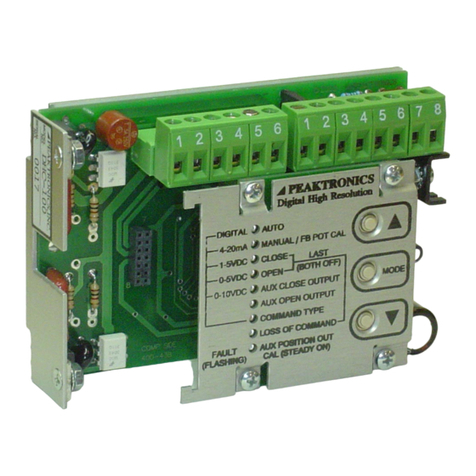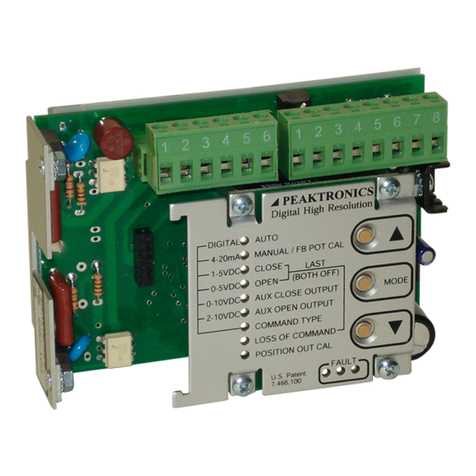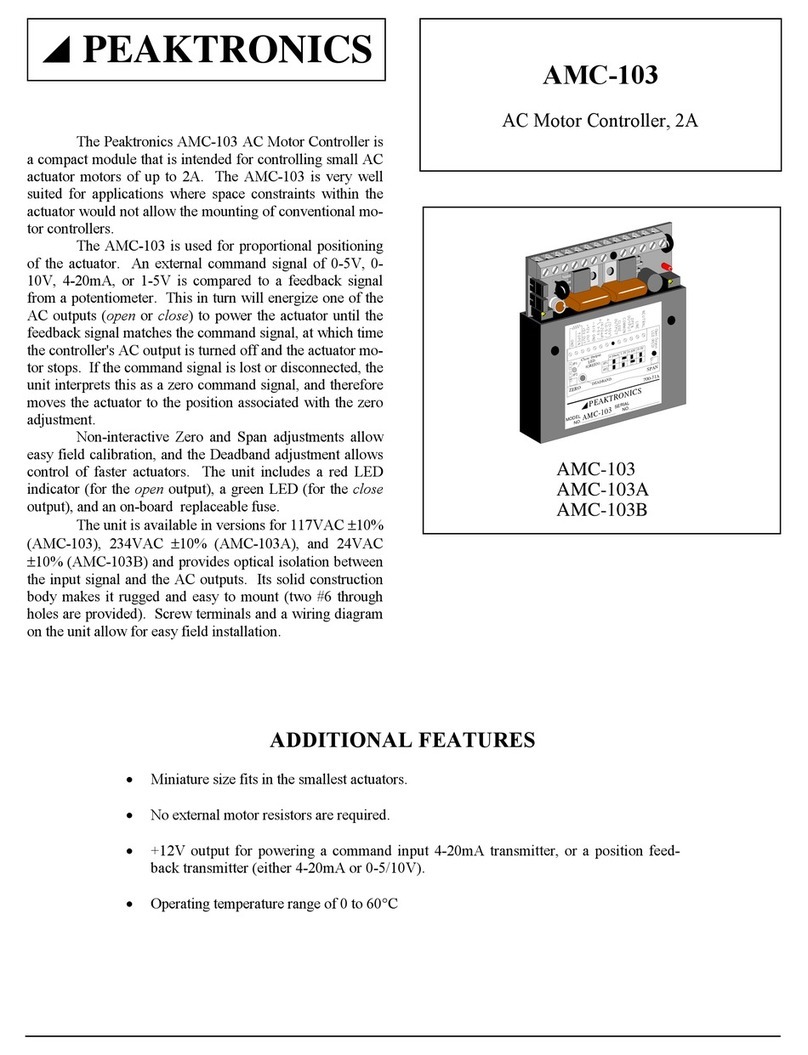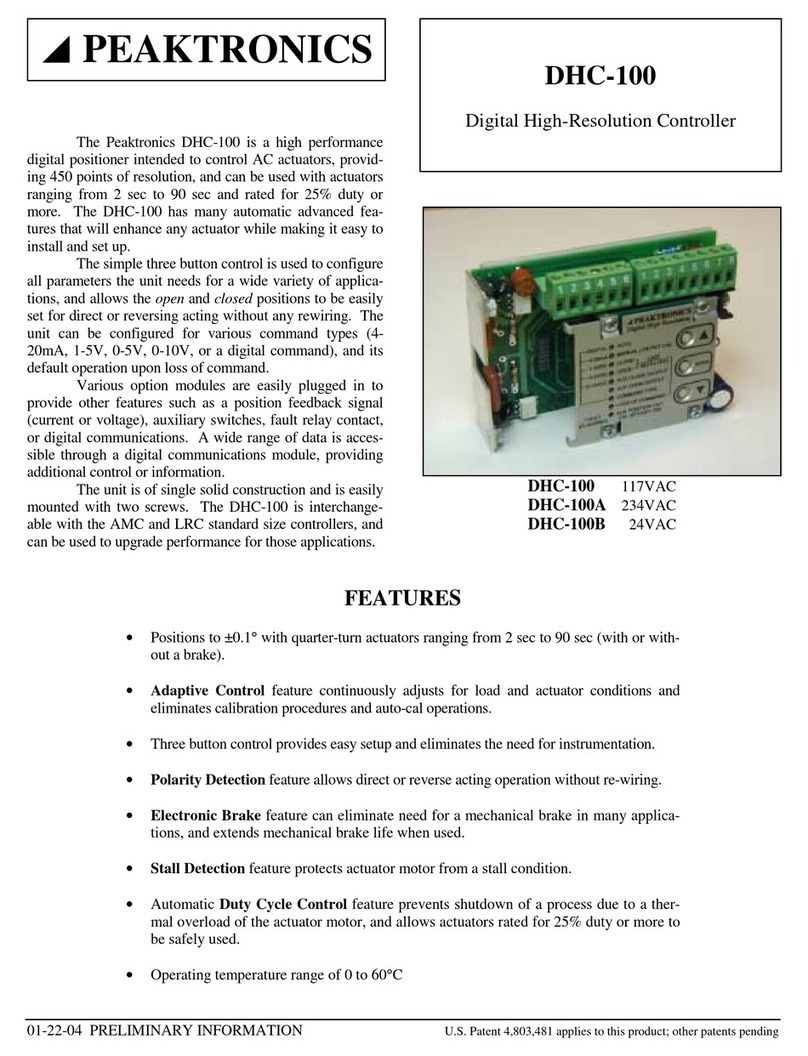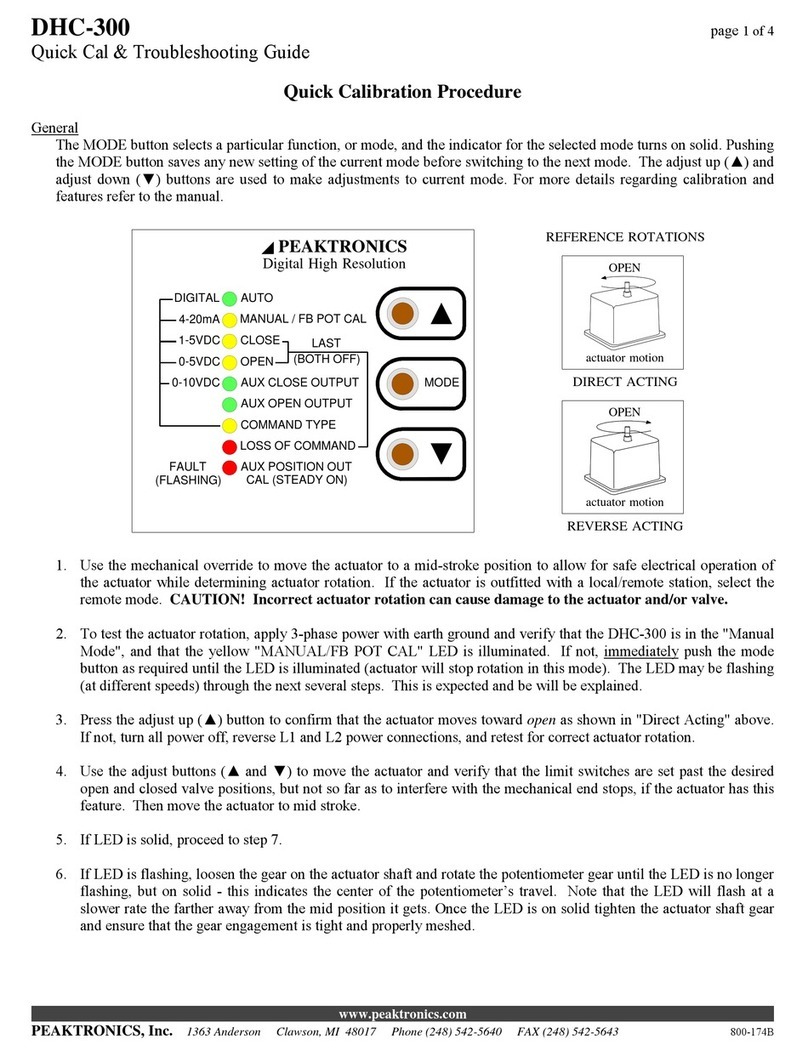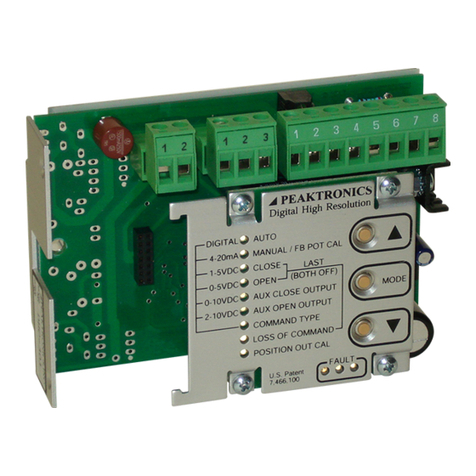
DHC-100
6 U.S. Patent 7,466,100 applies to this product PEAKTRONICS
Upon selecting the CLOSE function, the DHC-
100 will begin moving the actuator to the previously set
closed position; it is not necessary to make an adjustment
if the unit has been previously set to the desired position.
A command signal input of 0V, 1V, 2V, 4mA, or 0% au-
tomatically corresponds to the defined closed position.
OPEN
The OPEN function works the same way as the
CLOSE function with the exception that the adjust buttons
are used to set the desired open position. As with the
CLOSE function, upon selecting the OPEN function, the
actuator will move to the previously set open position.
Once the desired position is set, the DHC-100 will auto-
matically correspond a command signal input of 10V, 5V,
20mA, or 100% to the open position.
AUX CLOSE OUTPUT
The AUX CLOSE OUTPUT function is used to
set an optional output setting that is associated with the
closed position - an appropriate relay option module is
required to use this output. The adjust buttons are used to
set the actuator to a desired position. Whenever the actua-
tor position falls between the defined closed position and
the Aux Close position, the Aux Close Output indicator
will flash. Additionally, the DHC-100 will turn on a relay
output on the optional relay module - the output can be
used to drive an alarm or merely act as an auxiliary limit
switch.
Upon selecting the AUX CLOSE OUTPUT func-
tion, the DHC-100 will begin moving the actuator to the
previously set position. It is not necessary to make an ad-
justment if the unit has been previously set to the desired
position.
AUX OPEN OUTPUT
The AUX OPEN OUTPUT function is used to set
an optional output setting that is associated with the open
position - an appropriate relay option module is required
to use this output. The adjust buttons are used to set the
actuator to a desired position. Whenever the actuator po-
sition falls between the defined open position and the Aux
Open position, the Aux Open Output indicator will flash.
Additionally, the DHC-100 will turn on a relay output on
the optional relay module - the output can be used to drive
an alarm or merely act as an auxiliary limit switch.
Upon selecting the AUX OPEN OUTPUT func-
tion, the DHC-100 will begin moving the actuator to the
previously set position. It is not necessary to make an ad-
justment if the unit has been previously set to the desired
position.
COMMAND TYPE
The COMMAND TYPE function is used to con-
figure the command signal input for either 4-20mA, 1-5V,
0-5V, 0-10V, 2-10V, or Digital so as to match the type of
command signal being used. Upon selecting the COM-
MAND TYPE function, the Command Type indicator will
turn on steady, while the indicator for the selected type
will flash. Use the adjust buttons (▲ or ▼) to select the
desired input type. The selection will be saved when the
MODE button is pressed, which will also advance the unit
to the LOSS OF COMMAND function.
LOSS OF COMMAND
When using 1-5V, 2-10V, 4-20mA, or a Digital
input type for the command signal, the DHC-100 will de-
tect when the command signal is lost or out of range. A
loss of command condition is detected whenever the input
is disconnected, the input becomes less than 0.75V (for 1-
5V input), 1.5V (for 2-10V input) or 3mA, or the input is
connected backwards. An out of range condition is de-
tected whenever the input becomes greater than 5.25V (for
1-5V input), 10.5V (for 2-10V ipnut), or 21mA. If the
DHC-100 detects a loss of the command, a fault will be
indicated (see FAULT INDICATORS), and the actuator
will be moved to one of three preset positions: the open
position, the closed position, or the position last attained
prior to losing the command signal. The LOSS OF
COMMAND function is used to set the desired default
position.
When the LOSS OF COMMAND function is se-
lected, the adjust buttons are used to set the default posi-
tion. The DHC-100 indicates the selected default setting
by flashing the Open function indicator for the open de-
fault position, or it will flash the Close function indicator
for the closed default position. When neither indicator is
on, then the "last position" default is selected.
When a 0-5V or 0-10V command signal is used, a
loss of command signal cannot be reliably detected.
Therefore, if the unit is configured for a 0-5V or 0-10V
command signal (see COMMAND TYPE), the MODE
button will not select the LOSS OF COMMAND function.
However, the DHC-100 can detect when a 0-5V or 0-10V
command signal is out of range (i.e., greater than 5.25V or
greater than 10.5V) or connected backwards. When an
out of range condition is detected for a 0-5V or 0-10V in-
put, the motor is turned off (leaving the actuator in its "last
